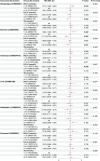Appraising associations between signature lipidomic biomarkers and digestive system cancer risk: novel evidences from a prospective cohort study of UK Biobank and Mendelian randomization analyses
- PMID: 38419059
- PMCID: PMC10900802
- DOI: 10.1186/s12944-024-02053-9
Appraising associations between signature lipidomic biomarkers and digestive system cancer risk: novel evidences from a prospective cohort study of UK Biobank and Mendelian randomization analyses
Abstract
Background: The roles of serum lipids on digestive system cancer (DSC) risk were still inconclusive. In this study, we systematically assessed indicative effects of signature lipidomic biomarkers (high-density lipoprotein cholesterol (HDL-C), low-density lipoprotein cholesterol (LDL-C), and triglycerides (TG)) on DSC (oesophagus, stomach, colorectal, liver, gallbladder, and pancreas cancers) risk.
Methods: HDL-C, LDL-C, and TG concentration measurements were respectively analyzed with enzyme immunoinhibition, enzymatic selective protection, and GPO-POD methods in AU5800 supplied from Beckman Coulter. The diagnoses of DSCs were coded using International Classification of Diseases, Tenth Revision (ICD-10) codes updated until October 2022 in the UK Biobank (UKB). In this study, we assessed phenotypic association patterns between signature lipidomic biomarkers and DSC risk using restricted cubic splines (RCSs) in multivariable-adjusted Cox proportional hazards regression models. Moreover, linear and nonlinear causal association patterns of signature lipidomic biomarkers with DSC risk were determined by linear and nonlinear Mendelian randomization (MR) analyses.
Results: A median follow-up time of 11.8 years was recorded for 319,568 participants including 6916 DSC cases. A suggestive independent nonlinear phenotypic association was observed between LDL-C concentration and stomach cancer risk (Pnonlinearity < 0.05, Poverall < 0.05). Meanwhile, a remarkable independent linear negative phenotypic association was demonstrated between HDL-C concentration and stomach cancer risk (Pnonlinearity > 0.05, Poverall < 0.008 (0.05/6 outcomes, Bonferroni-adjusted P)), and suggestive independent linear positive associations were observed between HDL-C concentration and colorectal cancer risk, and between TG concentration and gallbladder cancer risk (Pnonlinearity > 0.05, Poverall < 0.05). Furthermore, based on nonlinear and linear MR-based evidences, we observed an suggestive independent negative causal association (hazard ratio (HR) per 1 mmol/L increase: 0.340 (0.137-0.843), P = 0.020) between LDL-C and stomach cancer risk without a nonlinear pattern (Quadratic P = 0.901, Cochran Q P = 0.434). Meanwhile, subgroup and stratified MR analyses both supported the category of LDL-C ≥ 4.1 mmol/L was suggestively protective against stomach cancer risk, especially among female participants (HR: 0.789 (0.637-0.977), P = 0.030) and participants aged 60 years or older (HR: 0.786 (0.638-0.969), P = 0.024), and the category of TG ≥ 2.2 mmol/L concluded to be a suggestive risk factor for gallbladder cancer risk in male participants (HR: 1.447 (1.020-2.052), P = 0.038) and participants aged 60 years or older (HR: 1.264 (1.003-1.593), P = 0.047).
Conclusions: Our findings confirmed indicative roles of signature lipidomic biomarkers on DSC risk, notably detecting suggestive evidences for a protective effect of high LDL-C concentration on stomach cancer risk, and a detrimental effect of high TG concentration on gallbladder cancer risk among given participants.
Keywords: Causal associations; Digestive system cancer risk; Linear and nonlinear Mendelian randomization analysis; Phenotypic associations; Polygenic risk score; Signature lipidomic biomarkers.
© 2024. The Author(s).
Conflict of interest statement
The authors declare no competing interests.
Figures





Similar articles
-
Investigating linear and nonlinear associations of LDL cholesterol with incident chronic kidney disease, atherosclerotic cardiovascular disease and all-cause mortality: A prospective and Mendelian randomization study.Atherosclerosis. 2023 Dec;387:117394. doi: 10.1016/j.atherosclerosis.2023.117394. Epub 2023 Nov 19. Atherosclerosis. 2023. PMID: 38029611
-
Associations of Serum Lipid Traits With Fracture and Osteoporosis: A Prospective Cohort Study From the UK Biobank.J Cachexia Sarcopenia Muscle. 2024 Dec;15(6):2669-2683. doi: 10.1002/jcsm.13611. Epub 2024 Oct 29. J Cachexia Sarcopenia Muscle. 2024. PMID: 39468953 Free PMC article.
-
The relationship between serum lipid with sarcopenia: Results from the NHANES 2011-2018 and bidirectional Mendelian randomization study.Exp Gerontol. 2024 Oct 15;196:112560. doi: 10.1016/j.exger.2024.112560. Epub 2024 Aug 29. Exp Gerontol. 2024. PMID: 39214262
-
Causal relationships involving brain imaging-derived phenotypes based on UKB imaging cohort: a review of Mendelian randomization studies.Front Neurosci. 2024 Jul 10;18:1436223. doi: 10.3389/fnins.2024.1436223. eCollection 2024. Front Neurosci. 2024. PMID: 39050670 Free PMC article. Review.
-
The Lipidomic Signature of Glioblastoma: A Promising Frontier in Cancer Research.Cancers (Basel). 2024 Mar 8;16(6):1089. doi: 10.3390/cancers16061089. Cancers (Basel). 2024. PMID: 38539424 Free PMC article. Review.
Cited by
-
NR0B2 Is a Key Factor for Gastric Diseases: A GEO Database Analysis Combined with Drug-Target Mendelian Randomization.Genes (Basel). 2024 Sep 16;15(9):1210. doi: 10.3390/genes15091210. Genes (Basel). 2024. PMID: 39336801 Free PMC article.
-
Advances in Precision Medicine Approaches for Colorectal Cancer: From Molecular Profiling to Targeted Therapies.ACS Pharmacol Transl Sci. 2024 Mar 19;7(4):967-990. doi: 10.1021/acsptsci.4c00008. eCollection 2024 Apr 12. ACS Pharmacol Transl Sci. 2024. PMID: 38633600 Free PMC article. Review.
-
Assessing the causal role of lipid metabolites in Alzheimer's disease: A mendelian randomization study.J Prev Alzheimers Dis. 2025 Apr;12(4):100067. doi: 10.1016/j.tjpad.2025.100067. Epub 2025 Jan 23. J Prev Alzheimers Dis. 2025. PMID: 39855965 Free PMC article.
-
Correlation between dyslipidaemia and gastric cancer: pathogenesis to prevention and treatment strategies.Lipids Health Dis. 2025 Jun 7;24(1):204. doi: 10.1186/s12944-025-02625-3. Lipids Health Dis. 2025. PMID: 40483484 Free PMC article. Review.
-
Genetically proxied risk and protective factors for pancreatic cancer: a systematic review and meta-analysis of Mendelian randomization studies.J Gastrointest Oncol. 2025 Jun 30;16(3):1233-1247. doi: 10.21037/jgo-2025-305. Epub 2025 Jun 27. J Gastrointest Oncol. 2025. PMID: 40672103 Free PMC article.
References
MeSH terms
Substances
Grants and funding
- 82002932/National Natural Science Foundation of China
- 81874279/National Natural Science Foundation of China
- 20210101333JC/Jilin Provincial Scientific and Technological Development Program
- YDZJ202201ZYTS133/Jilin Provincial Scientific and Technological Development Program
- 20210101436JC/Jilin Provincial Scientific and Technological Development Program
LinkOut - more resources
Full Text Sources
Medical
Miscellaneous

